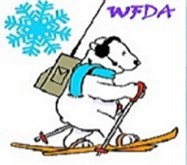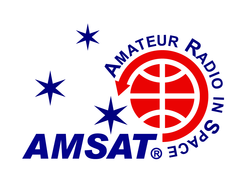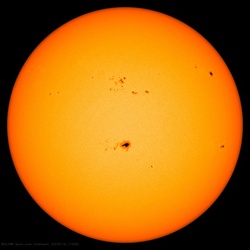 January 19, 2023 John E. Ross, KD8IDJ, Editor
| ||||||
Winter Field Day 2023 Winter Field Day (WFD), sponsored by the Winter Field Day Association, is coming again. This year, the dates are January 28 and WFD is a communications exercise and is held annually on the last full weekend in January. It can be worked from the comfort of your home or in a remote location. You can participate by yourself or get your friends, family, or whole club involved. WFD is open to participants worldwide. Amateur radio operators may use frequencies on the HF, VHF, or UHF bands, and are free to use any mode that can faithfully transmit the required exchange intact. Like the ARRL Field Day, bonus points are earned in several ways, including for using non-commercial power sources, operating from remote locations, making satellite contacts, and more. The Winter Field Day Association passionately believes that ham radio operators should practice portable emergency communications in winter environments, as the potential for freezing temperatures, snow, ice, and other hazards present unique operational concerns. WFD is formatted to help increase your level of preparedness for disasters and improve your operational skills in subpar conditions. Also, don't forget to mark your calendar for 2023 ARRL Field Day, June 24 - 25, 2023. Georgia State Parks On the Air The Georgia State Parks On the Air will be held April 1 - 2, 2023. ARRL member Claude Ray, AC4SH, said this is the first time that all of Georgia's 50 state parks have been involved. "The objective is to encourage ham radio operators to visit Georgia State Parks and experience the fun of Parks on the Air activations," said Ray. The entire process is largely based on the honor system, although logs of top activators will be cross-checked. The contest period begins at 0800 EDT, April 1, 2023, through 2000 EDT, April 2, 2023, and operating hours are subject to park rules and times. Participants with the top three scores in each of the five categories will receive a certificate indicating the award:
Every station participating in the event and submitting a log will, upon request, receive a Certificate of Participation indicating the number of parks contacted. Ray added, "There are 47 parks that already have at least one ham planning to activate on the April 1 - 2, 2023, weekend." See the complete rules at gaparks.org/rules. Amateur Satellite FalconSAT-3 Nears Reentry Many amateur radio operators and satellite watchers have been predicting the date and time of reentry for FalconSAT-3 (FS-3). While all reentry predictions are something of a guessing game due to the large number of variables affecting the upper atmosphere, it is certain that the end for FS-3 will be coming very soon, possibly the week of January 16 - 21, 2023. Radio Amateur Satellite Corporation (AMSAT) Board Member and FS-3 control operator, Mark Hammond, N8MH, said he will try to have the satellite operational for its final hours. The satellite has only been available for approximately 24 hours each weekend due to weak batteries.
FalconSAT-3 was built in 2005 and 2006 by cadets and faculty in the Space Systems Research Center at the US Air Force Academy (USAFA) in Colorado Springs, Colorado. It is the fourth in a series of small satellites designed, built, and operated there as part of a capstone course, which brings together about 30 cadets each year from several different academic departments. Nearly 700 cadets at the USAFA obtained their amateur radio licenses as part of training to operate FalconSAT-3 and other USAFA satellites. They have taken that knowledge, understanding, and value of amateur radio into their Air Force service and industry. Since FalconSAT-3, the USAFA Astronautics Department has built and operated one additional satellite and has two more queued for launch. The space operations curriculum and the ground station are being rebuilt and configured for these new space assets. Since its launch on an Atlas V rocket from Cape Canaveral in March 2007, the satellite has been through three mission phases. The first phase was operation of the science payloads. The second phase was used as a tool for training cadets in the space operations squadron, students in undergraduate space training in California, and graduate students at the Air Force Institute of Technology. The satellite's third phase was an on-orbit resource for amateur radio and amateur-satellite services operation managed by AMSAT.
The core avionics were designed and built by Mark Kanawati, N4TPY, and Dino Lorenzini, KC4YMG at SpaceQuest, and have performed remarkably well for nearly 16 years in orbit. Jim White, WD0E, was the lead engineer for FalconSAT-3 at the USAFA and managed the design, construction, testing, and early operations of the satellite. The success of FalconSAT-3 is an excellent example of how amateur radio can be integrated into the curriculum of an education institution for the benefit of the students and the amateur radio service. -- Thanks to Sasha Timokhov, VE3SVF; Jean Marc Momple, 3B8DU; Mark Hammond, N8MH; AMSAT Operations, and AMSAT News for the information contained in this story.
Amateur Radio in the News ARRL Public Information Officers, Coordinators, and many other member-volunteers help keep amateur radio and ARRL in the news. "Ham Radio Operators to Host Winter Field Day Event January 28th & 29th" / WTCA (Indiana), January 16, 2023. "Forget dot com, Americans are making a new dash for Morse code" / The Times (United Kingdom), January 11, 2023. Share any amateur radio media hits you spot with us. ARRL Podcasts
On the Air ARRL Audio News The On the Air podcast is available on iTunes (iOS) and Stitcher (Android). The On the Air podcast and ARRL Audio News are also on blubrry -- On the Air | ARRL Audio News. Announcements The North Coast Contesters will host the 29th Annual Dayton Contest Dinner. The dinner will be held at the Hope Hotel, located at Wright-Patterson Air Force Base in Dayton, Ohio, on Saturday night, May 20, 2023, at 6:30 PM. Social Hour opens at 5:30pm and dinner begins at 6:30 pm. Master of Ceremonies will be John Dorr, K1AR, and the 2023 Keynote Speaker is Bryant Rascoll, KG5HVO. Rascoll, of Montgomery, Alabama, was the 2018 recipient of the Bill Pasternak Memorial Amateur Radio Newsline Young Ham of the Year Award. He is also known as a competitive contester who is able to send CW over 60 WPM. The 2023 CQ Contest Hall of Fame inductees will also be announced during the 2023 Dayton Contest Dinner. Tickets are on sale now.
In Brief... The World Radiosport Team Championship Sanctioning Committee (WRTC-SC) is accepting proposals for hosting the 2026 WRTC event. The World Radiosport Team Championship is an on-site amateur radio competition, usually held every 4 years. Previous WRTCs have been held in Seattle, San Francisco, Slovenia, Finland, Brazil, Russia, Boston, and Germany. WRTC 2022, delayed due to the COVID-19 pandemic, is scheduled to be held in Bologna, Italy, in July 2023. Teams of two operators representing a geographical region of the world come to the host site to compete using similar antennas and locations, overseen by on-site referees. The WRTC competition has typically been held as a contest-within-a-contest coincident with the IARU HF World Championship to capitalize on the high activity of a popular world-wide operating event. Groups interested in hosting WRTC 2026 should submit a Letter of Intent, with a summary proposal no later than March 31, 2023, to the Chairman of the WRTC Sanctioning Committee, Tine Brajnik, S50A, via email to tine.brajnik@gmail.com.
The K7RA Solar Update Tad Cook, K7RA, of Seattle, Washington, reports for this week's ARRL Propagation Bulletin:
Last week's bulletin opened with "Wow!" I don't know what to say about this week, except it is beyond "wow!" This actually has me thinking about Cycle 19. Average daily sunspot numbers rose from 135.9 to 173.4, while average solar flux went to 221.8 from 181.2. From Spaceweather.com: "If sunspot production continues apace for the rest of January, the monthly sunspot number will reach a 20-year high." Average planetary A index increased from 6.7 to 13.9. On January 15, 2023, planetary A index reached a peak of 30, a very high value indicating a geomagnetic storm. Conditions were stormy throughout the week due to flares and coronal mass ejections. On that day in Fairbanks, Alaska, the college A index was 53. There was a large polar cap absorption event. Nine new sunspot groups appeared during this reporting week, January 12 - 18. One on January 12, four on January 13, two more on January 15, and two more, one each, on January 17 - 18. Predicted solar flux is 220, 218, 215, 212, and 210 on January 19 - 23; 206 on January 24 - 25; 200 and 190 on January 26 - 27; 185 on January 28 - 29; 190 on January 30 through February 2; 195 and 200 on February 3 - 4; 205 on February 5 - 6; 210 on February 7 - 11, then a big jump to 235 and 230 on February 12 - 13; 225 on February 14 - 16; 220 on February 17, and 215 on February 18 - 19. Predicted planetary A index is 16, 12, 16, 12 and 8 on January 19 -23; 5 on January 24 - 25; 8, 12, and 8 on January 26 - 28; 5 on January 29 - 31; 12 and 8 on February 1 - 2; 5 on February 3 - 6; 12, 12, 15, and 12 on February 7 - 10; 5 on February 11 - 13, then 8, 15, 10, and 7 on February 14 - 17. Sunspots in the news: In Friday's bulletin, look for a report from KA3JAW about his recent experiences on 10 -meter FM. Sunspot numbers January 12 - 18, 2023, were 151, 181, 170, 177, 186, 185, and 164, with a mean of 173.4. The 10.7-centimeter flux was 211.6, 208.5, 227.8, 234.3, 228.1, 221.7, and 220.3, with a mean of 221.8. Estimated planetary A indices were 9, 12, 11, 30, 14, 6, and 15, with a mean of 13.9. Middle latitude A index was 8, 10, 9, 17, 10, 5, and 11, with a mean of 10. Send your tips, questions, or comments to k7ra@arrl.net. A comprehensive K7RA Solar Update is posted Fridays on the ARRL website. For more information concerning radio propagation, visit the ARRL Technical Information Service, read "What the Numbers Mean..." and check out the Propagation Page of Carl Luetzelschwab, K9LA. A propagation bulletin archive is available. For customizable propagation charts, visit the VOACAP Online for Ham Radio website. Share your reports and observations. A weekly, full report is posted on ARRL News. Just Ahead in Radiosport
Visit the ARRL Contest Calendar for more events and information.
Upcoming Section, State, and Division Conventions
Search the ARRL Hamfest and Convention Database to find events in your area. Have News for ARRL? Submissions for the ARRL Letter and ARRL News can be sent to news@arrl.org. -- John E. Ross, KD8IDJ, ARRL News Editor
ARRL -- Your One-Stop Resource for
Subscribe to...
Free of charge to ARRL members...
| ||||||
 29. Radio clubs around the country are activating for this event. Complete rules can be found on the WFD website, at
29. Radio clubs around the country are activating for this event. Complete rules can be found on the WFD website, at  "This is a fun contest only, and the rules are minimal, the scoring is simple, and the main award is simply the fun of getting on the air."
"This is a fun contest only, and the rules are minimal, the scoring is simple, and the main award is simply the fun of getting on the air."
 For amateur radio service the downlink is at 435.103 MHz transmitting 1 W into a quarter-wave whip antenna. The uplink is at 145.840 MHz and the receiving antenna is a quarter-wave whip antenna on the opposite side of the satellite. All UHF and S-band equipment on National Telecommunications and Information Administration licensed frequencies has been disabled. The VHF receiver is very sensitive. Modulation is 9600 bps GMSK for the uplink and downlink. The broadcast call sign is PFS3-11, and the BBS callsign is PFS3-12, Unproto APRS via PFS3-1.
For amateur radio service the downlink is at 435.103 MHz transmitting 1 W into a quarter-wave whip antenna. The uplink is at 145.840 MHz and the receiving antenna is a quarter-wave whip antenna on the opposite side of the satellite. All UHF and S-band equipment on National Telecommunications and Information Administration licensed frequencies has been disabled. The VHF receiver is very sensitive. Modulation is 9600 bps GMSK for the uplink and downlink. The broadcast call sign is PFS3-11, and the BBS callsign is PFS3-12, Unproto APRS via PFS3-1..jpg)

-2023.jpg)
-Blue.jpg)








